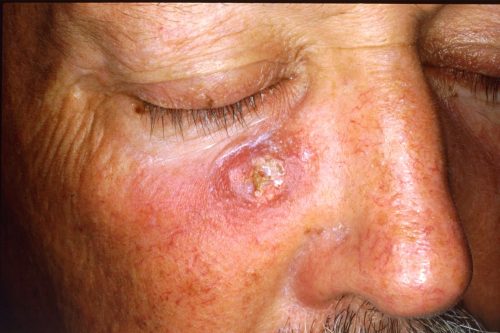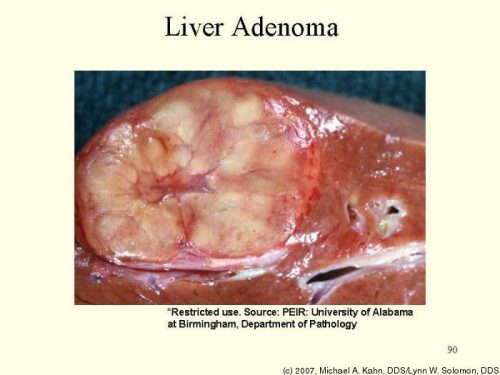
Every cell in the body has a regulated system and life cycle dictating when it should grow, mature and die off. For various reasons, at some point, cells may lose control and begin to divide and grow uncontrollably leading to the formation of tumours or cancers [4]. Adenoma and carcinoma are two oncology related terms that share a range of similar features with regards to diagnosis and treatments however they do still differ in that adenomas are known to develop in glands that secrete fluids such as sweat glands and salivary glands and are known as benign tumours while carcinomas are known to develop in the epithelial tissues and are malignant tumours derived from epithelial tissues [1].
What is a carcinoma?
Carcinomas are the medical term given to one of the most common types of cancer in humans [2]. They are defined as abnormal growths or proliferations of cells that are known to originate in epithelial tissues that line a range of internal structures within the body. This proliferation of cellular growth usually develops when there is a disruption to regular cell growth and balances within the body. Carcinomas are more commonly known as malignant tumours which simply translate into cancer-causing growths in the body.
Types of carcinomas
There are six main types of carcinomas affecting different areas of the body. The addition of a prefix to the word carcinoma indicates the localization of the cell proliferation [3]. Some examples of carcinomas types include 1) adreno-cortical carcinoma which affects the adrenal glands, 2) thyroid carcinoma which affects the thyroid glands, 3) naso-pharyngeal carcinoma which affects the nose and pharynx, 4) malignant melanoma which causes skin cancer, 5) skin carcinomas and 6) carcinomas known to affect the salivary glands, colon, appendix, lungs, cervix and bladder [1].
Causes of carcinomas
Carcinomas rarely occur before the onset of adolescence however the causes will vary depending on the affected body region. A range of factors are known to be cancer causing agents leading to the development of carcinomas such as family genetics, radiation, UV rays exposure and smoking [1]. Ultraviolet light whether it be from the sun or skin tanning beds are known to lead to changes in cellular growth or damage of DNA while immunosuppressant drugs may also lead to some forms of skin carcinomas [4]. These varying factors may all lead to damage in DNA which inevitably result to the formation of carcinomas.
Symptoms of carcinomas
There are a range of symptoms associated with the various carcinomas however these depend on the location and severity of the growth. These symptoms include shortness of breath, chronic coughing which may subsequently lead to bleeding, chest pains, altered bowl habits, weakness, fatigue, fever, loss of weight and appetite, sweating and chills [1]. Patients may also notice a skin growth in the form of a dome shape. These bumps are usually pink, black or brown in colour and may be waxy or hard skinned in appearance and touch. Some of these domes may also be fragile such that they begin to bleed easily.
Diagnosis of carcinomas
Carcinomas are generally diagnosed through biopsies which involve removal of portion of the suspected tissue followed by observation under microscopes to detect abnormally divided cells. Further analysis of patients by CT or MRI scans can be used to identify the exact location of the carcinoma. Additional analyses such as PET (position emission tomography) can also be used to determine the type of carcinoma present.
Treatment of carcinomas
A range of treatments are available for carcinomas and these are usually based on the type, location and severity of the carcinoma as well as the health and fitness of the affected patient. Treatment includes chemotherapy, radiation, surgery and targeted therapies with the main goal of removing the malignant tumour and leaving as small a scar as possible [1]. Treatment may include 1) excision of cancerous cells, 2) scraping away the tumour followed by the use of electricity to kill any remaining cells or 3) cryosurgery involving the freezing of cancer cells with liquid nitrogen.

What is an adenoma?
Adenomas are defined as a non-cancerous or benign tumour that originates in some form of glandular tissue. These affected tissues form part of the epithelial tissues and can be present on various different parts in the body, lining skin, glands and even cavities of organs. Since adenomas are most commonly found in glandular tissues, these glands can be located anywhere in the body from the in the colon, to breasts , lungs and even in the throat. Adenomas that subsequently progress into cancer are then known as adenocarcinomas.
Types of adenomas
Adenomas are generally defined as benign, non-invasive tumours. There are a range of different types which vary from micro-adenomas to macro-adenomas. Micro-adenomas are smaller and do not press against any adjacent structures thereby limiting the amount of exerted pressure while macro-adenomas are larger and exert some form of pressure on surrounding structures. In addition, adenocarcinomas are developments that form when there is an uncontrolled proliferation of growth in any region of tissue [2].
Causes of adenomas
While the exact cause of adenomas may still be undefined, it is thought that genetics play an important part in adenoma development. Certain types of adenomas are more common in one gender as opposed to another, for example pituitary tumours and liver adenomas are more common in women while others such as colon adenomas are more common in older adults. Hormonal contraception and certain medication may also cause the development of liver adenomas in women.
Symptoms of adenomas
Non-specific symptoms are commonly experienced by patients with adenomas and no single set of symptoms can be applied generally. The signs and symptoms depend on the location of the adenomna however common symptoms include body aches, fatigue, and weakness, loss of both weight and appetite. Lumps may also develop however these are signs of adenocarcinomas which may in turn be cancerous. Examples of location specific symptoms include 1) abdominal pains, loss of weight, headaches, sweating and chest pains for adrenocortical carcinomas, 2) persistent diarrhoea for colon carcinomas and blood coughs, fever, chills and shortness of breath in lung carcinomas.
Diagnosis of adenomas
Diagnosis is commonly made based on symptoms, medical history and physical findings on the respective patient. A variety of techniques are available to aid adenoma detection. These include detection of elevated hormone levels in blood and urine samples as well as detection using a combination of ultrasonography, CT scans and MRI’s. Since adenomas are known to be benign, it is also common to perform a biopsy to determine if the tumour is benign or malignant.
Treatment of adenomas
Treatment will depend on several factors such as the size of the adenoma; the extent by the tumour has invaded surrounding tissues and patient age and health. Surgical removal is usually performed to remove adenomas and over time, these surgical removal techniques has had major advances to now include the use of high-definition endoscopy and more effective closure methods [5]. This is the recommended treatment for most adenomas. Symptoms of adenomas are most often treated with medication and in many cases it has been reported that treatment has led to curing of the condition [4].
Difference between adenoma and carcinoma
The biggest difference between these two kinds of growth proliferations are that adenomas develop in glands which secrete fluids like sweat, saliva and breast milk while carcinomas are known to originate in epithelial tissues such as the lining of breasts, lungs and prostate glands. While adenomas can affect people are any stage of life, carcinomas rarely affect children before adolescence. Adenomas most commonly show up in the form of lumps bulging through the skin while the presence of carcinomas is dependent on the location, size and degree of growth proliferation.
Summary of differences between adenomas and carcinomas
| Adenomas | Carcinomas |
| Adenomas develop in glands which secret fluids | Carcinomas develop in tissues that line the inner or outer surfaces of the body |
| Adenomas are known to be benign | Carcinomas are known to be malignant |
| Adenomas can affect people at any age | Carcinomas affect older individuals and rarely affect children before adolescence |
| Adenomas are usually associated with lumps protruding through the skin | Carcinomas may be present as lumps but may also not be visually present. This will depend on the affected site, size and severity of growth. |











Leave a Reply